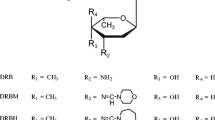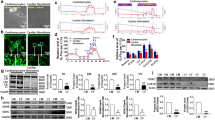Abstract
Doxorubicin (Dox) is a very potent antineoplastic agent used against several types of cancer, despite a cumulative cardiomyopathy that reduces the therapeutic index for treatment. H9c2 myoblast cells have been used as an in vitro model to study biochemical alterations induced by Dox treatment on cardiomyocyte cells. Despite the extensive work already published, few data are available regarding morphological alterations of H9c2 cells during Dox treatment. The purpose of the present work was to evaluate Dox-induced morphological alterations in H9c2 myoblasts, focusing especially on the nuclei, mitochondria, and structural fibrous proteins. Treatment of H9c2 cell with low concentrations of Dox causes alterations in fibrous structural proteins including the nuclear lamina and sarcomeric cardiac myosin, as well as mitochondrial depolarization and fragmentation, membrane blebbing with cell shape changes, and phosphatidylserine externalization. For higher Dox concentrations, more profound alterations are evident, including nuclear swelling with disruption of nuclear membrane structure, mitochondrial swelling, and extensive cytoplasm vacuolization. The results obtained indicate that Dox causes morphological alterations in mitochondrial, nuclear, and fibrous protein structures in H9c2 cells, which are dependent on the drug concentration. Data obtained with the present study allow for a better characterization of the effects of Dox on H9c2 myoblasts, used as a model to study Dox-induced cardiotoxicity. The results obtained also provide new and previously unknown targets that can contribute to understand the mechanisms involved in the cardiotoxicity of Dox.









Similar content being viewed by others
Abbreviations
- DIC:
-
differential interference contrast
- Dox:
-
doxorubicin
- LDH:
-
lactate dehydrogenase
- PS:
-
phosphatidylserine
- ROS:
-
reactive oxygen species
- TMRM:
-
tetramethylrhodamine methyl ester
References
Ben Yaou R, Gueneau L, Demay L, et al. Heart involvement in lamin A/C related diseases. Arch Mal Coeur Vaiss. 2006;99(9):848–55.
Bergmeyer HU, Bernt E. Lactate-dehydrogenase, UV-assay with pyruvate and NADH. In: Bergmeyer HU, editor. Methods of enzymatic analysis (vol. 2). New York: Academic; 1974.
Berthiaume JM, Wallace KB. Adriamycin-induced oxidative mitochondrial cardiotoxicity. Cell Biol Toxicol. 2007;23(1):15–25.
Box VG. The intercalation of DNA double helices with doxorubicin and nagalomycin. J Mol Graph Model. 2007;26(1):14–9.
Bridger JM, Foeger N, Kill IR, et al. The nuclear lamina. Both a structural framework and a platform for genome organization. FEBS J. 2007;274(6):1354–61.
Brostrom MA, Reilly BA, Wilson FJ, et al. Vasopressin-induced hypertrophy in H9c2 heart-derived myocytes. Int J Biochem Cell Biol. 2000;32(9):993–1006.
Chua CC, Liu X, Gao J, et al. Multiple actions of pifithrin-alpha on doxorubicin-induced apoptosis in rat myoblastic H9c2 cells. Am J Physiol Heart Circ Physiol. 2006;290(6):H2606–13.
Croft DR, Coleman ML, Li S, et al. Actin-myosin-based contraction is responsible for apoptotic nuclear disintegration. J Cell Biol. 2005;168(2):245–55.
Cutts SM, Nudelman A, Rephaeli A, et al. The power and potential of doxorubicin-DNA adducts. IUBMB Life. 2005;57(2):73–81.
Cutts SM, Parsons PG, Sturm RA, et al. Adriamycin-induced DNA adducts inhibit the DNA interactions of transcription factors and RNA polymerase. J Biol Chem. 1996;271(10):5422–9.
Davies KJ, Doroshow JH. Redox cycling of anthracyclines by cardiac mitochondria. I. Anthracycline radical formation by NADH dehydrogenase. J Biol Chem. 1986;261(7):3060–7.
Dechat T, Shimi T, Adam SA, et al. Alterations in mitosis and cell cycle progression caused by a mutant lamin A known to accelerate human aging. Proc Natl Acad Sci U S A. 2007;104(12):4955–60.
Dudnakova TV, Lakomkin VL, Tsyplenkova VG, et al. Alterations in myocardial cytoskeletal and regulatory protein expression following a single doxorubicin injection. J Cardiovasc Pharmacol. 2003;41(5):788–94.
Fadeel B, Kagan VE. Apoptosis and macrophage clearance of neutrophils: regulation by reactive oxygen species. Redox Rep. 2003;8(3):143–50.
Frost BM, Eksborg S, Bjork O, et al. Pharmacokinetics of doxorubicin in children with acute lymphoblastic leukemia: multi-institutional collaborative study. Med Pediatr Oncol. 2002;38(5):329–37.
Gabrielson K, Bedja D, Pin S, et al. Heat shock protein 90 and ErbB2 in the cardiac response to doxorubicin injury. Cancer Res. 2007;67(4):1436–41.
Garrido C, Galluzzi L, Brunet M, et al. Mechanisms of cytochrome c release from mitochondria. Cell Death Differ. 2006;13(9):1423–33.
Grimmond HE, Beerman T. Alteration of chromatin structure induced by the binding of adriamycin, daunorubicin and ethidium bromide. Biochem Pharmacol. 1982;31(21):3379–86.
Hescheler J, Meyer R, Plant S, et al. Morphological, biochemical, and electrophysiological characterization of a clonal cell (H9c2) line from rat heart. Circ Res. 1991;69(6):1476–86.
Iwasaki T, Suzuki T. Ultrastructural alterations of the myocardium induced by doxorubicin. A scanning electron microscopic study. Virchows Arch B Cell Pathol Incl Mol Pathol 1991;60(1):35–9.
Jang YM, Kendaiah S, Drew B, et al. Doxorubicin treatment in vivo activates caspase-12 mediated cardiac apoptosis in both male and female rats. FEBS Lett. 2004;577(3):483–90.
Jones SM, Kirby MS, Harding SE, et al. Adriamycin cardiomyopathy in the rabbit: alterations in contractile proteins and myocyte function. Cardiovasc Res. 1990;24(10):834–42.
Joyeux M, Godin-Ribuot D, Faure P, et al. Heat stress protects against electrophysiological damages induced by acute doxorubicin exposure in isolated rat hearts. Cardiovasc Drugs Ther. 2001;15(3):219–24.
Kalyanaraman B, Joseph J, Kalivendi S, et al. Doxorubicin-induced apoptosis: implications in cardiotoxicity. Mol Cell Biochem 2002;234–5(1–2):119–24.
Kim DS, Kim HR, Woo ER, et al. Inhibitory effects of rosmarinic acid on adriamycin-induced apoptosis in H9c2 cardiac muscle cells by inhibiting reactive oxygen species and the activations of c-Jun N-terminal kinase and extracellular signal-regulated kinase. Biochem Pharmacol. 2005;70(7):1066–78.
Kim DS, Woo ER, Chae SW, et al. Plantainoside D protects adriamycin-induced apoptosis in H9c2 cardiac muscle cells via the inhibition of ROS generation and NF-kappaB activation. Life Sci. 2007;80(4):314–23.
Kim JE, Han BS, Choi WS, et al. Temporospatial sequence of cellular events associated with etoposide-induced neuronal cell death: role of antiapoptotic protein Bcl-X(L). J Neurosci Res. 2001;66(6):1074–82.
Kimes BW, Brandt BL. Properties of a clonal muscle cell line from rat heart. Exp Cell Res. 1976;98(2):367–81.
L’Ecuyer T, Horenstein MS, Thomas R, et al. Anthracycline-induced cardiac injury using a cardiac cell line: potential for gene therapy studies. Mol Genet Metab. 2001;74(3):370–9.
L’Ecuyer T, Sanjeev S, Thomas R, et al. DNA damage is an early event in doxorubicin-induced cardiac myocyte death. Am J Physiol Heart Circ Physiol. 2006;291(3):H1273–80.
Li K, Sung RY, Huang WZ, et al. Thrombopoietin protects against in vitro and in vivo cardiotoxicity induced by doxorubicin. Circulation. 2006;113(18):2211–20.
Lieberman J, Fan Z. Nuclear war: the granzyme A-bomb. Curr Opin Immunol 2003;15(5):553–9.
Lushnikova EL, Klinnikova MG, Molodykh OP, et al. Morphological manifestations of heart remodeling in anthracycline-induced dilated cardiomyopathy. Bull Exp Biol Med. 2004;138(6):607–12.
Menna P, Salvatorelli E, Minotti G. Doxorubicin degradation in cardiomyocytes. J Pharmacol Exp Ther. 2007;322(1):408–19.
Merten KE, Jiang Y, Feng W, et al. Calcineurin activation is not necessary for doxorubicin-induced hypertrophy in H9c2 embryonic rat cardiac cells: involvement of the phosphoinositide 3-kinase-Akt pathway. J Pharmacol Exp Ther. 2006;319(2):934–40.
Muntoni F. Cardiomyopathy in muscular dystrophies. Curr Opin Neurol. 2003;16(5):577–83.
Oliveira PJ, Wallace KB. Depletion of adenine nucleotide translocator protein in heart mitochondria from doxorubicin-treated rats–relevance for mitochondrial dysfunction. Toxicology 2006;220(2–3):160–8.
Palle J, Frost BM, Peterson C, et al. Doxorubicin pharmacokinetics is correlated to the effect of induction therapy in children with acute myeloid leukemia. Anticancer Drugs. 2006;17(4):385–92.
Park C, So HS, Shin CH, et al. Quercetin protects the hydrogen peroxide-induced apoptosis via inhibition of mitochondrial dysfunction in H9c2 cardiomyoblast cells. Biochem Pharmacol. 2003;66(7):1287–95.
Perrot A, Sigusch HH, Nagele H, et al. Genetic and phenotypic analysis of dilated cardiomyopathy with conduction system disease: demand for strategies in the management of presymptomatic lamin A/C mutant carriers. Eur J Heart Fail. 2006;8(5):484–93.
Potemski P, Polakowski P, Wiktorowska-Owczarek AK, et al. Amifostine improves hemodynamic parameters in doxorubicin-pretreated rabbits. Pharmacol Rep. 2006;58(6):966–72.
Prasad S, Soldatenkov VA, Srinivasarao G, et al. Intermediate filament proteins during carcinogenesis and apoptosis (Review). Int J Oncol. 1999;14(3):563–70.
Rasola A, Bernardi P. The mitochondrial permeability transition pore and its involvement in cell death and in disease pathogenesis. Apoptosis. 2007;12(5):815–33.
Santos DL, Moreno AJ, Leino RL, et al. Carvedilol protects against doxorubicin-induced mitochondrial cardiomyopathy. Toxicol Appl Pharmacol. 2002;185(3):218–27.
Schafer ZT, Kornbluth S. The apoptosome: physiological, developmental, and pathological modes of regulation. Dev Cell. 2006;10(5):549–61.
Shimasaki H, Ueta N, Mowri HO, et al. Formation of age pigment-like fluorescent substances during peroxidation of lipids in model membranes. Biochim Biophys Acta. 1984;792(2):123–9.
Solem LE, Heller LJ, Wallace KB. Dose-dependent increase in sensitivity to calcium-induced mitochondrial dysfunction and cardiomyocyte cell injury by doxorubicin. J Mol Cell Cardiol. 1996;28(5):1023–32.
Spallarossa P, Garibaldi S, Altieri P, et al. Carvedilol prevents doxorubicin-induced free radical release and apoptosis in cardiomyocytes in vitro. J Mol Cell Cardiol. 2004;37(4):837–46.
Takemura G, Fujiwara H. Doxorubicin-induced cardiomyopathy from the cardiotoxic mechanisms to management. Prog Cardiovasc Dis. 2007;49(5):330–52.
Taylor AL, Bulkley BH. Acute adriamycin cardiotoxicity: morphologic alterations in isolated perfused rabbit heart. Lab Invest. 1982;47(5):459–64.
Terman A, Brunk UT. Autophagy in cardiac myocyte homeostasis, aging, and pathology. Cardiovasc Res. 2005;68(3):355–65.
Ueno M, Kakinuma Y, Yuhki K, et al. Doxorubicin induces apoptosis by activation of caspase-3 in cultured cardiomyocytes in vitro and rat cardiac ventricles in vivo. J Pharmacol Sci. 2006;101(2):151–8.
Unverferth DV, Magorien RD, Unverferth BP, et al. Human myocardial morphologic and functional changes in the first 24 hours after doxorubicin administration. Cancer Treat Rep. 1981;65(11–12):1093–7.
Villani F, Galimberti M, Monti E, et al. Effect of ICRF-187 pretreatment against doxorubicin-induced delayed cardiotoxicity in the rat. Toxicol Appl Pharmacol. 1990;102(2):292–9.
von Harsdorf R, Li PF, Dietz R. Signaling pathways in reactive oxygen species-induced cardiomyocyte apoptosis. Circulation. 1999;99(22):2934–41.
Wallace KB. Doxorubicin-induced cardiac mitochondrionopathy. Pharmacol Toxicol. 2003;93(3):105–15.
Wattanapitayakul SK, Chularojmontri L, Herunsalee A, et al. Screening of antioxidants from medicinal plants for cardioprotective effect against doxorubicin toxicity. Basic Clin Pharmacol Toxicol. 2005;96(1):80–7.
Wayman N, McDonald MC, Thompson AS, et al. 5-Aminoisoquinolinone, a potent inhibitor of poly (adenosine 5'-diphosphate ribose) polymerase, reduces myocardial infarct size. Eur J Pharmacol. 2001;430(1):93–100.
Xu MF, Tang PL, Qian ZM, et al. Effects by doxorubicin on the myocardium are mediated by oxygen free radicals. Life Sci. 2001;68(8):889–901.
Yan L, Vatner DE, Kim SJ, et al. Autophagy in chronically ischemic myocardium. Proc Natl Acad Sci U S A. 2005;102(39):13807–12.
Yue TL, Wang C, Romanic AM, et al. Staurosporine-induced apoptosis in cardiomyocytes: a potential role of caspase-3. J Mol Cell Cardiol. 1998;30(3):495–507.
Zhou S, Palmeira CM, Wallace KB. Doxorubicin-induced persistent oxidative stress to cardiac myocytes. Toxicol Lett. 2001;121(3):151–7.
Acknowledgment
This work was supported by NIH grant HL 58016 to K.W., by FCT grant PTDC-SAU-OSM-64084-2006 to P.J.O. and by fellowships SFRH/BD/10251/2002 and SFRH/BPD/8359/2002 from the Portuguese Foundation for Science and Technology to V.S. and P.J.O., respectively.
Author information
Authors and Affiliations
Corresponding author
Rights and permissions
About this article
Cite this article
Sardão, V.A., Oliveira, P.J., Holy, J. et al. Morphological alterations induced by doxorubicin on H9c2 myoblasts: nuclear, mitochondrial, and cytoskeletal targets. Cell Biol Toxicol 25, 227–243 (2009). https://doi.org/10.1007/s10565-008-9070-1
Received:
Accepted:
Published:
Issue Date:
DOI: https://doi.org/10.1007/s10565-008-9070-1




